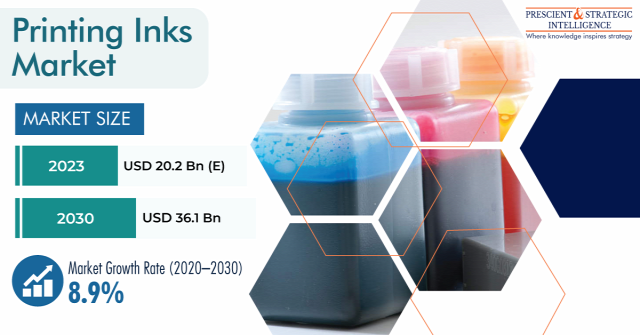The printing ink market was valued at USD 20.2 billion in 2023 and is projected to reach USD 36.1 billion by 2030 , with a growth rate of 8.9% from 2024 to 2030.
During the projection period, the market is projected to grow moderately due to its already
huge size. The industry is mainly propelled by the growing requirement for colorful wrapping with sharp characters and text in the personal care & cosmetics and food & beverages sectors.

Furthermore, the rising need for paperboard & cardboard packing with the thriving e-commerce industry has boosted the usage of inks for printing purposes. Likewise, the need will remain strong in the future because of the growing requirement for wrapping items and commercial printing, with the changing customer preferences.
The increasing utilization of printing inks in commercial printing, industrial printing, publication, and packaging applications is projected to fuel the industry's advance in the coming years. Printing inks are widely used in numerous food packaging applications, on materials such as paper, cardboard boards, multilayered materials, and plastics.
On the basis of product, in 2023, the lithographic inks category will dominate the industry, and the category is also projected to grow at a substantial pace in the coming years. This is primarily because these variants provide a high print quality with considerable effectiveness, mainly with regard to handling huge projects.
In 2023, on the basis of formulation, the oil-based category is generating significant revenue share. The growing need for oil-based printing inks arises from their broad applications throughout numerous sectors, mainly packaging, publication, and commercial printing.
In 2023, the labels and packaging category, based on application, led the industry. The explosive growth of the middle-class populations in emerging economies, such as Thailand and India, has led to a sharp rise in consumerism and an accompanying surge for packaged products.
On the basis of applications, in 2023, the labels and packaging category dominated the market. the explosive development of middle-class populations in developing economies, like India and Thailand, has led to a sharp increase in consumerism and an accompanying rise in packaged products.
In 2023, the Asia-Pacific region played a crucial role in driving the industry forward. The increased demand for packaged food items, coupled with rapid advances in labeling and packaging, has bolstered growth in this area. Moreover, the expanding food and beverage, healthcare, e-commerce, and consumer goods industries are key factors propelling market growth in the region.

